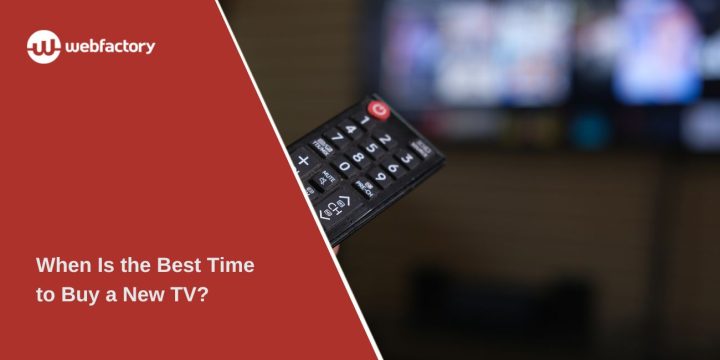Buying a new TV isn’t just about finding the right size or brand; it’s also about buying at the right time. TV prices change throughout the year, and catching the right sale can save you hundreds of dollars.
If you’re wondering when to pull the trigger, you’re not alone. Between new model launches, holiday sales, and random price drops, it’s hard to know when you’re truly getting a good deal. Let’s break it down so you know exactly when and why to buy a new TV and when to wait.
What Affects TV Prices Throughout the Year?
TV prices shift for several reasons, including product cycles, competition, and retail sales events. Most manufacturers release new models early in the year, right after the Consumer Electronics Show (CES) in January. Once those hit stores, older models get discounted to make room for new stock.
Retailers also plan their sales calendars strategically around sports events, holidays, and shopping seasons. So even if the newest models are on shelves, you might still find solid deals on last year’s TVs.
Another key factor is technology upgrades. As new features like OLED, QLED, or Mini-LED panels appear, previous versions drop in price even if they still look great.
The Best Times of Year to Buy a TV
If you’re looking to maximize savings, these are the best windows to shop for a new TV:
1. Super Bowl Season (January–February)
Retailers know millions of people are upgrading before the big game. Big-screen TVs, especially 65-inch and larger models, often see strong discounts. This is one of the best times to buy high-end sets.
2. Spring Model Changeover (March–April)
New TVs announced at CES start arriving in stores. To clear old inventory, stores drop prices on last-year models. These older sets often have the same specs for hundreds less.
3. Amazon Prime Day (July)
This mid-summer sales event brings heavy discounts on electronics, including TVs. Competing retailers like Best Buy and Walmart often run their own promotions at the same time.
4. Back-to-School and Labor Day (August–September)
While not as major as Black Friday, this is a good time for budget and mid-range TVs. Students and families shopping for dorms and apartments create demand, which brings discounts on smaller and mid-size models.
5. Black Friday and Cyber Monday (November)
This is the biggest sales event of the year for electronics. Every major brand, including Samsung, LG, Sony, and TCL, cuts prices deeply. Just make sure you research models ahead of time so you don’t get lured by low-quality “doorbuster” models explicitly made for sales.
6. Post-Holiday Clearance (December–January)
After Christmas, stores clear out remaining inventory to make space for new year releases. This is one of the quietest but most rewarding times to buy if you’re not chasing the latest model.
When You Should Wait
Sometimes, waiting saves more than rushing. You should hold off buying a TV if:
- New models are about to release. Prices on current models drop soon after.
- Your current TV still works well. There’s no point paying full price if you don’t need an upgrade.
- You’re targeting a premium model. High-end OLED and 8K TVs usually get their best discounts months after launch.
If you’re not in a rush, patience pays off.
How to Decide If You Should Buy Now or Wait
Here’s a simple way to decide:
- Assess your needs. Is your TV failing, or are you just ready for an upgrade?
- Track prices. Use tools like Honey, CamelCamelCamel, or Google Shopping to monitor drops.
- Compare last-year vs current models. Most “new” TVs only add minor upgrades like brighter panels or faster processors.
- Set a clear budget. Don’t get caught chasing new tech if it doesn’t add real value for you.
If you find a solid deal that fits your needs, buy it because waiting too long can mean missing out once the stock runs out.
What to Look for When You Find a Good Deal
Before you hit “buy,” double-check the essentials:
- Panel types include OLED for deep blacks, QLED for bright rooms, and LED for budget options.
- Resolution: 4K is the sweet spot. 8K still costs more than it’s worth.
- Refresh rate: 120Hz, ideal for gaming or watching sports.
- Warranty and return policy: This is especially important for online purchases.
- Price match guarantees: Many retailers match lower prices if found elsewhere.
- Real discount check: Compare the sale price to historic prices to see if it’s truly a deal.
Sometimes last year’s model is the smarter buy, it’s cheaper and still packed with top-tier features.
Regional and Online Shopping Considerations
If you’re outside the U.S., local timing can vary. In Europe, big discounts often happen during Boxing Day and January sales. In Asia or the Middle East, local electronics festivals and regional holidays create similar opportunities.
Online retailers also run flash deals year-round, so checking official brand stores or verified sellers on Amazon can score you unexpected discounts.
Final Thoughts
So, when’s the best time to buy a new TV? It depends, but generally, February, spring clearance, and Black Friday offer the most significant savings.
If your TV still works fine, it’s worth waiting for those windows. But if you find a solid deal on a reputable model, don’t overthink it; grab it before it’s gone.
The key is planning. Watch prices, set alerts, and buy during major events instead of random weeks. With the right timing, you’ll enjoy your new screen without overpaying.
